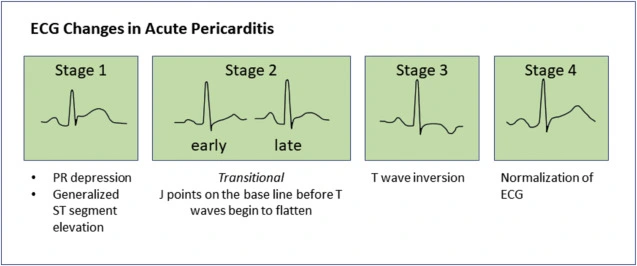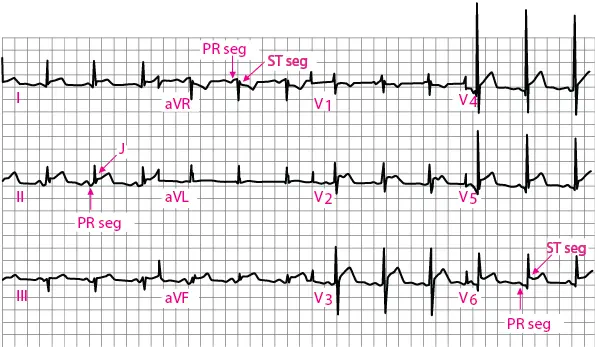Table of Contents
Know about Pericarditis ECG Mnemonic
The electrocardiogram (ECG or EKG) is a crucial instrument in the field of medical diagnostics that enables medical practitioners to evaluate the electrical activity of the heart. Pericarditis is a disorder that frequently confounds both medical experts and students. A mnemonic comes to the rescue to aid in the comprehension of pericarditis and its electrocardiographic symptoms. In this post, we examine the pericarditis notion, decipher the pericarditis ECG mnemonic, and explain the importance of the mnemonic.
Understanding Pericarditis
What is Pericarditis?
The term “pericarditis” describes an inflammation of the pericardium, a delicate membrane that surrounds the heart. Numerous factors, including bacterial infections, autoimmune diseases, viral infections, and even heart attacks, might contribute to this illness. Chest pain brought on by the inflammation, which is frequently described as severe and stabbing, gets worse with deep breaths or adjustments to one’s posture.
Causes of Pericarditis
Viral illnesses like the flu or bacterial infections like tuberculosis can cause pericarditis. Additionally, autoimmune conditions like lupus may play a role in its emergence. Pericarditis can occasionally result from cardiac surgery or heart attacks.
Symptoms and Diagnosis
Chest pain, fever, breathing difficulties, and a feeling of pressure on the chest are all typical signs of pericarditis. Clinical evaluation, a review of the patient’s medical history, a physical examination, and several tests, such as electrocardiograms (ECGs) to look for distinctive ECG alterations, are all used to make the diagnosis.
Deciphering ECG
What is an Electrocardiogram (ECG)?
A non-invasive medical test called an electrocardiogram, often known as an ECG or EKG, measures the electrical activity of the heart over time. This test aids medical experts in evaluating the heart’s rhythm, spotting anomalies, and spotting probable cardiac problems.
Importance in Cardiac Diagnostics
Arrhythmias, heart attacks, and pericarditis are just a few of the disorders that can be diagnosed with ECGs. ECGs offer important information about the general health and performance of the heart by detecting the electrical impulses produced by the heart.
ECG Waves and Intervals
Each wave and interval on the ECG graph correspond to a distinct stage of the heart cycle. The P wave, QRS complex, T wave, and PR interval are a few of these. Changes in these components may be a sign of anomalies or specific heart diseases.
The Pericarditis ECG Mnemonic
Components of the Pericarditis ECG Mnemonic
To remember the distinctive ECG alterations connected to pericarditis, use the pericarditis ECG mnemonic. Each letter in the mnemonic “pericarditis” stands for a distinctive characteristic seen in an affected patient’s ECG.

Application in Clinical Practice
The PERICARDITIS mnemonic makes it easier to recognize ECG alterations that are connected to pericarditis, allowing medical professionals to make precise and fast diagnoses. To comprehend the meaning of the mnemonic, let’s examine its components.
Breaking Down the Mnemonic
P for PR Depression
The PR segment frequently exhibits depression in pericarditis, indicating pericardial inflammation. This out-of-the-ordinary behavior is a critical sign of pericarditis.
E for Elevation
Elevated ST segments in several ECG leads are one of the defining symptoms of pericarditis. Usually, this elevation is widespread and not restricted to a particular coronary artery area.

R for Reciprocal Changes
ST-segment depressions in leads opposite to those with raised ST segments are referred to as reciprocal alterations. Due to the conflicting electrical forces produced by the inflamed pericardium, these alterations take place.
I for Improvement Over Time
In contrast to myocardial infarctions, pericarditis’ ECG abnormalities usually get better with time and the right care. Monitoring these alterations can give important information about how the illness is developing.
C for Concave ST Segments
Compared to myocardial infarctions, pericarditis frequently results in ST segments that have a distinctive concave shape, which distinguishes them from those that appear convex. An important diagnostic criterion is its concavity.
Significance in Diagnosis
Distinguishing Pericarditis from Myocardial Infarction
In order to distinguish pericarditis from myocardial infarction, which exhibits some similar ECG abnormalities, the pericarditis ECG mnemonic is crucial. The distinctiveness of the mnemonic facilitates precise distinction.
Recognizing ECG Patterns
Healthcare workers can readily identify the distinctive ECG signals connected to pericarditis by employing the mnemonic. This detection speeds up the diagnosis process and provides information on effective treatment plans.
Clinical Utility
Enhancing Differential Diagnosis
The mnemonic helps healthcare professionals distinguish between pericarditis and other cardiac illnesses that appear with similar ECG abnormalities, improving the accuracy of differential diagnosis. In patient care, this specificity is invaluable.
Providing Rapid Assessment
In an emergency, a quick and precise diagnosis is essential. The pericarditis ECG mnemonic is a quick assessment tool that enables medical practitioners to quickly decide on the best course of action.
Advantages and Limitations
Benefits of the Mnemonic
In clinical practice, the pericarditis ECG mnemonic offers a number of benefits. Its simplicity makes it easier to spot pericarditis-related ECG alterations quickly, which helps with fast diagnosis and suitable patient management. The mnemonic’s mnemonic qualities also help medical professionals remember and recall important information despite the complexity of clinical practice.
Cases Where Mnemonic Might Not Apply
The mnemonic is a useful tool, but it’s crucial to remember that no diagnostic tool is faultless. There may be times when the components of the mnemonic do not exactly match the ECG changes. For a proper diagnosis in such circumstances, clinical judgment and assessment of the patient’s entire health are crucial.
Remembering the Mnemonic
Tips for Memorization
Following a few straightforward guidelines can make it simpler to remember the pericarditis ECG mnemonic:
- Practice: Regularly review the mnemonic to reinforce memory.
- Use Flashcards: Create flashcards with the mnemonic’s components for quick recall.
- Clinical Cases: Apply the mnemonic to actual ECGs to solidify understanding.
- Teaching Others: Teaching the mnemonic to peers can enhance memory retention.
Pericarditis ECG Mnemonic Reinforcement
Consider spreading the mnemonic among medical professionals, employing it in classroom settings, and incorporating it into medical curriculum to increase its potency. The use of the mnemonic can be reinforced to increase diagnostic precision in a variety of healthcare settings.
Conclusion
Understanding ECGs can be difficult in the field of cardiology but is essential for making appropriate diagnoses. The pericarditis ECG mnemonic is a tremendous help in identifying the distinctive ECG alterations connected to pericarditis. Healthcare workers can improve their diagnostic skills, which will ultimately result in better patient care and results, by dissecting the mnemonic’s components and comprehending its relevance.
FAQs
Q: How is pericarditis diagnosed other than through ECG?
A: Clinical evaluation, a review of medical history, a physical examination, and imaging tests like echocardiograms (low voltage complex in ECG) can all be used to identify pericarditis. These techniques add to ECG results and aid in a thorough diagnosis.
Q: Can pericarditis lead to complications if not treated?
A: Yes, untreated pericarditis can result in consequences including cardiac tamponade (compression of the heart as a result of excessive fluid buildup) and pericardial effusion (collection of fluid surrounding the heart). It is essential to diagnose and treat such issues as soon as they arise.
Q: Is pericarditis a common condition?
A: Pericarditis is a somewhat common condition that can affect people of all ages. It’s crucial to be aware of its symptoms and to get help from a doctor if any are noticed.
Q: Are there variations in the ECG patterns of pericarditis?
A: Yes, depending on the underlying etiology and unique patient characteristics, pericarditis-related ECG patterns can differ. The pericarditis ECG mnemonic offers a rough guideline, but precise interpretation requires clinical judgment.
Q: Can individuals without medical backgrounds understand the pericarditis ECG mnemonic?
A: The mnemonic’s components can be communicated to people without medical training even though it is intended for use by medical experts. But it is best to leave precise diagnosis to qualified medical professionals.
